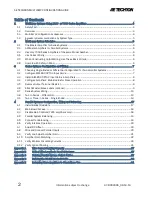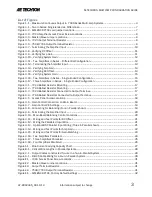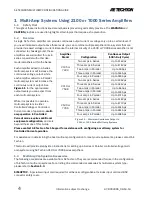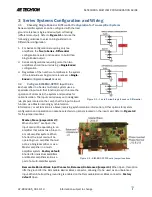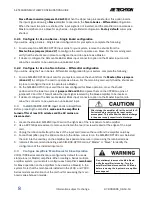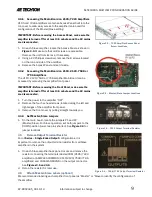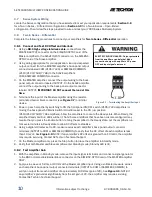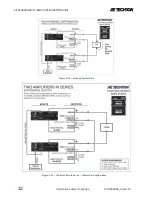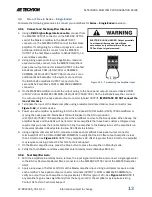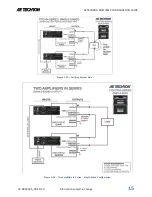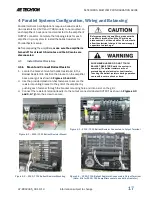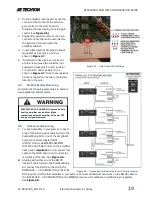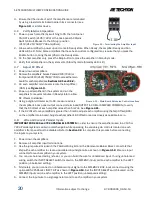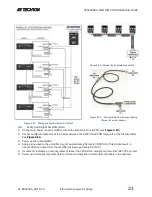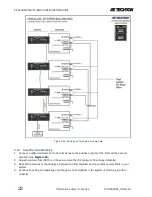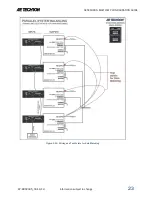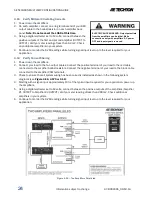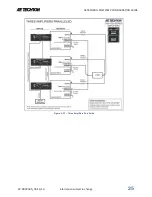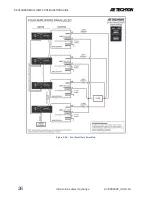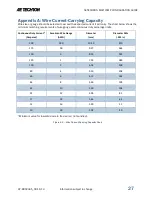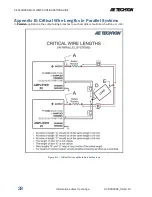
AE TECHRON MULTI-AMP CONFIGURATION GUIDE
97-8002465_09-19-14
Information subject to change
13
Figure 3.12 – Terminating the Amplifier Input
3.9
Two or Three in Series – Single Ended
Complete the following procedures to connect your amplifiers for
Series – Single-Ended
operation.
3.9.1
Connect and Test Amplifier Interlock
Using a
DB-9 high-voltage interlock cable,
connect from
1.
the MASTER OUTPUT connector on the SIM-BNC-OPTOC
card of the Master amplifier to the SLAVE INPUT
connector on the SIM-BNC-OPTOC card of the first Slave
amplifier. If configuring for a three amp system, use an
additional DB-9 cable to connect from the MASTER
OUTPUT of the first Slave amplifier to SLAVE INPUT on a
second Slave amplifier.
Using wiring appropriate for your application, load and
2.
expected output, connect from the MASTER amplifier’s
back-panel output connector labeled OUTPUT to the first
SLAVE amplifier’s COM (2105/7224) or SAMPLED
COMMON (2110/2120/7548/7796) connector. For an
additional SLAVE amplifier in the system, connect from
the first SLAVE amplifier’s OUTPUT connector to the
second SLAVE amplifier’s COM or SAMPLED COMMON
connector.
On the MASTER amplifier, connect the output wiring to the back-panel output connector labeled COM
3.
(2105/7224) or SAMPLED COMMON (2110/2120/7548/7796). On the last SLAVE amplifier, connect
the output wiring to the back-panel output connector labeled OUTPUT.
IMPORTANT: DO NOT connect the
load at this time.
Terminate the input of the Master amplifier using a resistor-terminated barrier block connector (see
4.
Figure 3.12
) or similar device.
Power up each amplifier by switching to ON the front-panel ON/OFF switch (2105/7224 amplifiers) or
5.
moving the back-panel AC Mains Switch/Circuit Breaker to the ON (up) position
(2110/2120/7548/7796 amplifiers). Allow the amplifiers to come to the Ready state. When Ready, the
amplifier Ready and Run LEDs will be lit. Note: Some amplifiers that have been custom-configured may
require that you press the Enable button to bring the amplifier to the Ready state. Let the amplifiers run
for several minutes in Ready state to allow DC offsets to stabilize.
Using a digital voltmeter set to DC, measure across each amplifier’s back-panel output connector
6.
terminals (OUTPUT to COM or SAMPLED COMMON) to verify that the DC offset of each amplifier is less
than 10 mVdc. See
Figure 3.13.
NOTE: If any amplifier’s DC offset is greater than 10 mVdc, the amplifier
may require servicing. Contact AE Techron Technical Support.
On the Master amplifier only, press the Stop button to place the amplifier in Standby mode.
7.
Verify that both Master and Slave amplifier enter Standby mode (Standby LED is lit).
8.
3.9.2
Test Amplifier Gain
With the amplifiers in Standby mode, remove the input signal termination and connect a signal generator
1.
to the BNC or Removable Barrier Block connector on the SIM-BNC-OPTOC card of the MASTER amplifier
ONLY.
Apply a sine wave of 5Vrms at 100 Hz at the Master amplifier input. Using a voltmeter measure across
2.
each amplifier’s back-panel output connector terminals (OUTPUT to COM or SAMPLED COMMON) to
verify an output from each amplifier of approximately 100Vrms (gain of 20). See
Figure 3.14.
NOTE: If
any amplifier’s gain varies significantly from the set gain of 20, the amplifier may require servicing.
Contact AE Techron Technical Support.
ELECTRIC SHOCK HAZARD. Output potentials
from the amplifiers can be lethal. Make
connections only with
amplifiers’ AC power
OFF and input signals removed.


